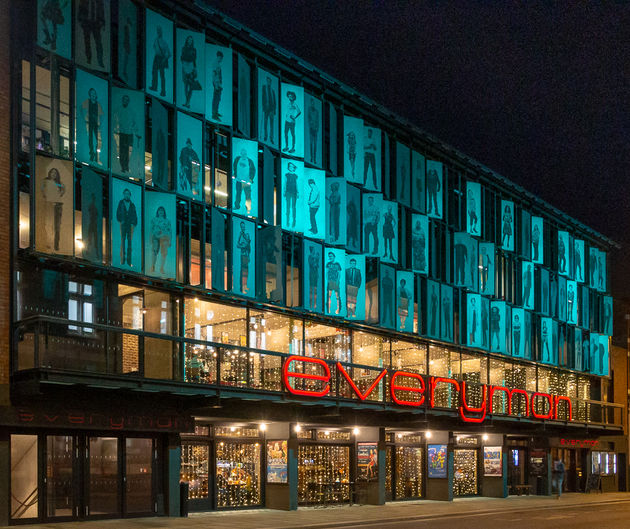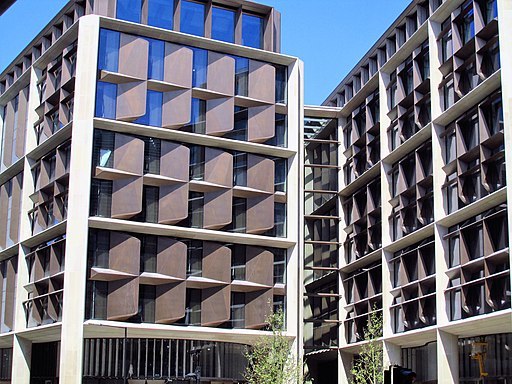 Haworth Tompkins instigated the declaration. The practice won the Stirling in 2014 for the Everyman Theatre in Liverpool by Haworth Tompkins. Photo by Ruth W via Flickr
Haworth Tompkins instigated the declaration. The practice won the Stirling in 2014 for the Everyman Theatre in Liverpool by Haworth Tompkins. Photo by Ruth W via Flickr
All 17 previous winners of the Stirling Prize have united to call for action from the industry on climate change, signing a declaration calling it a ‘climate and biodiversity emergency’. The practices released a letter at the end of May, calling climate change and biodiversity loss ‘the most serious issue of our time’ and highlighting the construction industry’s impact on both.
According UK government figures, buildings and construction account for around 45% of the UK’s CO2 emissions. Cement production alone is responsible for 8% of global CO2 emissions, Chatham House estimates. The 17 Stirling Prize winners – Alison Brooks Architects, Allford Hall Monaghan Morris, AL_A, Caruso St John Architects, David Chipperfield Architects, dRMM, Feilden Clegg Bradley Studios, Foster + Partners, Haworth Tompkins, Hodder + Partners, Maccreanor Lavington, Michael Wilford, Rogers Stirk Harbour + Partners, Stanton Williams, WilkinsonEyre, Witherford Watson Mann and Zaha Hadid Architects – addressed the industry’s impact on the world, pledging to ‘strengthen our working practices to create architecture and urbanism that has a more positive impact on the world’. Their letter declaring the emergency listed 11 points of action for firms to take and coincided with the launch of a website, architectsdeclare.com, on which they invite other industry professionals to join them by signing up. In the first day after its launch, 77 practices signed up.
 Foster + Partners won the Stirling in 2018 for Bloomberg’s European headquarters in London
Foster + Partners won the Stirling in 2018 for Bloomberg’s European headquarters in London
The list of pledges includes a call for greater focus on extending the use of existing buildings, upgrading buildings rather than demolishing or building from scratch when feasible. Other practical ambitions include the use of life cycle costing and carbon modelling throughout the building’s whole life span as standard in the basic scope of works, advocating for ‘regenerative design practices’ and government funding to support them, and encouraging clients and suppliers to take action on climate change.
Several of the Stirling Prize winners won their awards for buildings with green credentials, including the latest winner, Foster + Partners, which won for the Bloomberg building in 2018, which had BREEAM Outstanding status and the highest design-stage score for any major office development, though some in the industry critcized the building’s embodied carbon footprint. Other notable winners include dRMM’s salvaged timber regeneration of Hastings Pier, the 2017 winner, one of a number of projects by the firm using timber. Several of the architects have existing successes in repurposing existing buildings: both Feilden Clegg Bradley Studio and Haworth Tompkins completed refurbishments of theatre buildings in 2018 – the former completed Alexandra Palace’s restoration and the latter completed Battersea Arts Centre’s regeneration after a fire in 2015.
![]() Detail from the FCBS restoration of Alexandra Palace theatre. Photo by Lloyd Winters
Detail from the FCBS restoration of Alexandra Palace theatre. Photo by Lloyd Winters
Steve Tompkins, director at Haworth Tompkins, initiated the declaration of emergency, and gathered the Stirling Prize winners to sign up. He encouraged architects to sign up, telling the RIBA Journal, ‘It’s not only people with impeccable sustainable credentials who should sign up. None of us has got this all right yet, but you don’t have to be perfect to make a move.’
The president of RIBA backed the project, praising the commitments made by the architects declaring and adding that RIBA would be taking actions, including ‘better embedding Post Occupancy Evaluation into the RIBA Plan of Work and the introduction of enhanced sustainability requirements in our awards criteria, and seeking to influence government policy on whole-life zero carbon regulation.’
Architects around the world have also made their own climate declarations, with Australian architects joining the campaign in August and the German profession declaring in November. Other sectors have also joined calls to urgently tackle climate change, with the cultural sector – including Tate and Somerset House – declaring a climate emergency in April.
This article was updated with new declarations in November 2019

















